The
mandatory requirements must be met for all outdoor lighting projects when
they are applicable. Mandatory requirements for outdoor lighting are specified in §110.9, §130.0, §130.2, and
§130.4. Mandatory requirements include lighting controls
devices and system requirements, outdoor lighting controls installation
requirements, luminaire shielding, and outdoor lighting control acceptance
testing.
6.4.1 Luminaire
Shielding and CALGreen BUG Requirements
The 2022 Energy Code
includes outdoor luminaire shielding requirements based on the luminaire’s
initial lumen rating. All outdoor luminaires that emit 6,200 initial lumens or
greater must comply with backlight, uplight, and glare (BUG) requirements
contained in §5.106.8 of the CALGreen Code (Title 24, Part 11).
The BUG
ratings assume that the light emitted from the luminaire is providing useful illuminance on
the task surfaces rather than scattering the light in areas where the light is
not needed or intended, such as toward the sky. These BUG ratings also increase
visibility because high amounts of light shining directly into observer’s eyes
are reduced, thus decreasing glare. Additionally, light pollution into
neighbors’ properties is reduced. The BUG requirements vary by outdoor
lighting zones which are described in section 6.3.
Luminaire
manufacturers are aware of the technical details of the BUG ratings and
typically provide the BUG ratings for their luminaires in product specifications
or cutsheets. In the rare occasions where the luminaire manufacturer does not
provide a BUG rating, it can be calculated with outdoor lighting software if the luminaire
photometric data is available.
There are
exceptions to the luminaire shielding and the BUG rating requirements in
CALGreen and the Energy Code.
The
following are the exceptions in CALGreen Section 5.106.8: (The information is
extracted from the 2022 CALGreen Code):
1.
Luminaires that qualify as exceptions in Sections 130.2(b)
and 140.7
of the California Energy Code
2.
Emergency lighting
3.
Building
façade meeting the requirements in Table 140.7-B of the California Energy
Code, Part 6
• Custom
features as allowed by the local enforcing agency, as permitted by Section 101.8
(of the CALGreen Code) Alternate materials, designs and methods of
construction
•
Luminaires with less than 6,200 initial luminaire lumens.
The
following are exceptions in §130.2 of the
Energy Code for outdoor lighting applications that are exempted from the
luminaire shielding requirements. In some of these applications lighting
directed sideways and upwards may be desirable.
•
Signs.
•
Lighting for building façades, public monuments, public art,
statues, and vertical surfaces of bridges.
•
Lighting required by a health or life safety statute, ordinance, or
regulation that may fail to meet the uplight and glare limits due to application
limitations.
•
Temporary outdoor lighting that does not persist beyond 60 consecutive
days or more than 120 days per year.
•
Replacement of existing pole mounted luminaires in hardscape areas that are spaced more
than six times the mounting height of the existing luminaires and the
replacement luminaire wattage is less than or equal to the wattage of the
original luminaires. In addition:
Where the
existing luminaire does not meet the BUG requirements in Section 130.2(b).
Where no
additional poles are being added to the site.
Where new
wiring to the luminaires is not being installed.
• Luminaires
that light the public right of way including publicly maintained or
utility-maintained roads, sidewalks, or bikeways.
In addition, local
ordinance may have a more stringent outdoor lighting BUG requirements than that
of the CALGreen Code — the local ordinance would govern the outdoor lighting BUG
requirements in that scenario.
Example 6-2:
Question
Which outdoor lighting are exempted from the CALGreen
requirements in Section 5.106.8?
Answer
Certain categories of outdoor lighting luminaires are
exempted from the light pollution reduction requirements of CALGreen Code
Section 5.106.8, and they are as follows.
First, outdoor lighting luminaires with less than 6,200
initial luminaire lumens are exempted.
Second, listed below are additional outdoor lighting luminaires which
are also exempted. (Listed below are for a quick reference. For more details,
see the box further below.)
•
Outdoor
lighting with custom features as allowed by Section 101.8 of the California
CALGreen Code.
•
Outdoor
luminaires exempted in §130.2(b) and §140.7 of the California Energy Code.
•
Building façade
lighting indicated in Table 140.7-B of the California Energy Code.
•
Emergency
lighting.
Example 6-3:
Question
How do you determine the glare
rating for a luminaire located in Lighting Zone 3?
Reference
(Relevant information extracted from the 2022 CALGreen
Code and they are included here for reference.)
CALGreen
5.106.8.2 Facing – Glare.
For luminaires covered by Section 5.106.8.1 of the
CALGreen Code, if a property line also exists within or extends into the front
hemisphere within two mounting heights (2 MH) of the luminaire, then the
luminaire shall comply with the more stringent glare rating specified in Table
5.106.8 based on the lighting zone and distance to the nearest point on the
nearest property line within the front hemisphere.
CALGreen Table 5.106.8

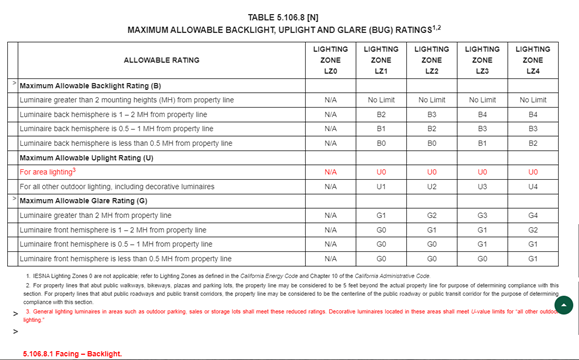
Images
Source: California Energy Commission. (The information is extracted
from the 2022 CALGreen Code and included here for reference.)
Answer
Start by looking up Table 5.106.8 of CALGreen Code.
Refer to Column 5 for Lighting Zone 3. The top rows show
the backlight rating, the two rows in the middle show the glare rating, and the
bottom rows show the uplight rating.
Next, determine the glare rating from the bottom rows
and locate the values from Column 5.
See below for a summary of information related to the
luminaires in this example for Lighting Zone 3.
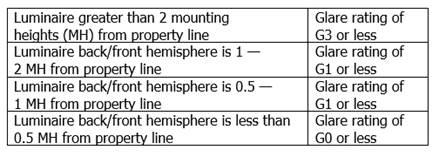
Images
Source: California Energy Commission. (The information is extracted from the 2022
CALGreen Code and included here for reference to the above example.)
The maximum allowable glare rating for Lighting Zone 3
ranges from G3, G1, and G0 and the glare rating would depend on the location of
the luminaire from a property line.
The glare rating is the maximum allowable rating and
therefore any rating that is less than the maximum rating is also allowed. For
luminaires located greater than two mounting heights from a property line, a
luminaire with a glare rating of G3, G2, G1, or G1 meets the requirement.
Example 6-4:
Question
How do you determine glare requirements for the
luminaires shown in the pictures below and are located in Lighting Zone
3?


Images
Source: courtesy of Lithonia Lighting, a part of Acuity Brands Lighting &
Controls.
Answer
First, determine if the luminaire is located within two
mounting heights (2 MH) of distance from property line, and refer to Table
5.106.8 of the CALGreen code for the allowable glare rating.
If the distance is greater than 2 MH, the glare rating
of the luminaire must be G3 or less (i.e., G2, G1 or G0).
If the distance is within one to two mounting heights
(MH) of distance from the property line, the glare rating of the luminaire must
be G1 or less (i.e., G0).
Similarly, if the distance is within a half to one
mounting height of distance from the property line, the glare rating of the
luminaire must be G1 or less (i.e., G0).
If the distance is less than a half mounting height of
distance from the property line, the glare rating of the luminaire must be
G0.
The above could also be summarized in a tabular format
as follows.
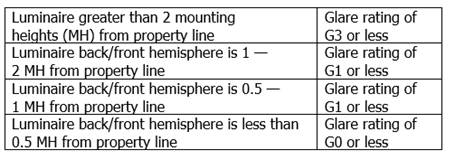
Images
Source: California Energy Commission. (The information is extracted from the
2022 CALGreen Code Table 150.6.8 and included here for reference to the above
example.)
Example 6-5:
Question
How do you determine backlight requirements for the
luminaire shown in the picture below and the luminaires are located in Lighting
Zone 3?

Images
Source: courtesy of Lithonia Lighting, a part of Acuity Brands Lighting &
Controls.
Reference
(This information below is extracted from the 2022
CALGreen Code and included here for reference.)
CALGreen 5.106.8.1 Facing — Backlight
Luminaires within two mounting heights (2 MH) of a
property line shall be oriented so that the nearest property line is behind the
fixture, and shall comply with the backlight rating specified in Table
5.106.8 based on the lighting zone and
distance to the nearest point of that property line.
Exception: Corners. If two property lines
(or two segments of the same property line) have equidistant points to the
luminaire, then the luminaire may be oriented so that the intersection of the
two lines (the corner) is directly behind the luminaire. The luminaire shall
still use the distance to the nearest point(s) on the property lines to
determine the required backlight rating.
CALGreen Table 5.106.8


(The above information is
extracted from the 2022 CALGreen Code and included here for reference.)
Answer
First, if the luminaire is located at more than two
mounting height (2 MH) of distance from the property line, there is no mandatory
backlight rating (no limit on backlight) for the luminaire.
For a luminaire located within two
mounting height (2 MH) of distance from the property line and that is not
exempt, the luminaire must comply with the backlight rating listed in Table
5.106.8.
For
a luminaire located in Lighting Zone 3 (LZ3) and within one to two mounting
heights (MH) of distance from the property line, the backlight rating of the
luminaire must be B4 or less (i.e., B3, B2, B1 or B0).
For
the same luminaire in LZ3 and within a half to one mounting height of distance
from the property line, the backlight rating of the luminaire must be B3 or less
(i.e., B2, B1 or B0).
For
the same luminaire in LZ3 and located less than a half mounting height of
distance from the property line, the backlight rating of the luminaire must be
B1 or less (i.e., B0).
The
above information could also be summarized in a tabular format below.
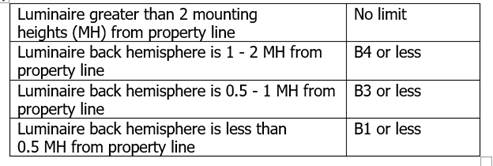
(This
information is extracted from the 2022 CALGreen Code.)
Example 6-6: Defining the Property Line for the Purpose
of BUG Rating Compliance
Question
Where is the property line if the area under
construction is located next to a public road?
Answer
For a property line that abuts a public roadway or
transit corridor, the property line may be the centerline of the public roadway
or transit corridor.
For a property lines that abuts a public walkway,
bikeway, plaza, or parking lot, the property line may be 5 feet beyond the actual
property line.
Example 6-7: Luminaire Classification for Outdoor
Luminaires
Question
What is the IES BUG system for outdoor
luminaires?
Answer
Illuminating Engineering Society (IES) published the
technical memorandum ’Luminaire Classification for Outdoor Luminaires’ (document
TM-15-20). This document defines three-dimensional regions of analysis for
exterior luminaires and further establishes zonal lumen limits for these regions
as part of a larger method of categorizing outdoor lighting equipment into backlight, uplight,
and glare components. Collectively, the three components are referred to as the
BUG system.
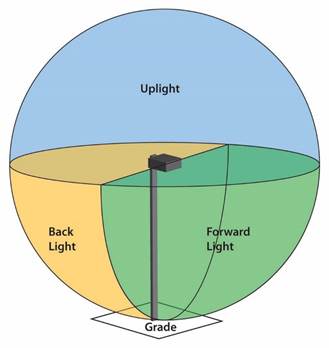
The Three Primary Solid Angles of the Luminaire Classification
System for Outdoor Luminaires
Image Source: Illuminating Engineering Society (image from ANSI/IES TM-15-20)
The zonal lumen limits per secondary solid angles for
uplight and glare are based upon the methodology found in TM-15. The lighting
zone in which the project is located determines the maximum zonal lumens for
backlight, uplight, and glare.
To
comply with this mandatory measure, the luminaire must not exceed the maximum
zonal lumen limits for each secondary solid angle region per lighting zone. The
zonal lumen values in a photometric test report must include any tilt or other
nonlevel mounting condition of the installed luminaire. The BUG rating
requirements can be found in CALGreen Code §5.106.8.
The BUG rating for luminaires may be determined with
outdoor lighting software or by contacting the manufacturer. There is also
software available to produce a BUG rating for a tilted luminaire condition
(which is not a typical circumstance for most applications). Since the
California BUG limits and calculation procedures match the IES, no deviation
from the IES BUG rating is necessary.
Example 6-8: Wallpacks and Zonal Lumen
Limits
Question
A new parking lot adjacent to a building is being
designed to be illuminated by wall packs rated at 7,000 initial luminaire
lumens. The wall packs are mounted on the side of the building, and their main
purpose is parking lot illumination. But they are also illuminating the façade of the
building. Do these wall packs have to meet the backlight, uplight, and glare
(BUG) rating limits?
Answer
Yes, these 7,000 lumen wall packs will have to meet the
BUG rating requirements because the main purpose is parking lot illumination.
Luminaire mounting methods or locations do not necessarily determine the purpose
of the illumination. Define the function of the luminaire by determining what
the majority of the light is striking. For a typical wall pack, 80% or more of
the light is likely striking the parking lot or sidewalk in front of the
building, and only 20% or less on the façade, so BUG rating limits
apply.
Each luminaire must be appropriately assigned to the
function area that it is illuminating, whether it is mounted to a pole,
building, or other structure. Only luminaires that are rated less than 6,200
initial luminaire lumens or outdoor lighting applications that are exempt, are
not required to meet the backlight, uplight, and glare (BUG) requirements in the
Energy Code.
Example 6-9: Tilted Luminaires Meeting the BUG
Requirements
Question
If a
low BUG rating luminaire is mounted at a tilt, does it still meet the BUG
requirements?
Answer
It
depends. Luminaires that meet the zonal lumen limits when mounted at 90° to
nadir may or may not comply with the BUG rating limits when they are mounted at
a tilt.
For a tilted luminaire to meet this requirement, a
photometric test report must be provided showing that the luminaire meets the
zonal lumen limits at the proposed tilt. There are lighting design software
available to calculate a BUG rating for a tilted luminaire, or this can be
provided by the manufacturer.
§130.2(c)|topic=(c) Controls for Outdoor Lighting.
The
primary requirements for outdoor lighting controls are as follows:
1. Daylight
Availability: All outdoor lighting shall be automatically controlled so that lighting is
off when daylight is available (§130.2(c)1|topic=(c) Controls
for Outdoor Lighting.).
2. Automatic
Scheduling Controls: All outdoor lighting shall be automatically controlled by a
time-based scheduling control (§130.2(c)2|topic=(c) Controls for Outdoor
Lighting.).
3.
Motion-Sensing Controls: Outdoor luminaires greater than 40 watts and
mounted 24 ft or less above the ground shall be controlled by motion-sensing
controls. This applies to luminaires providing general hardscape lighting, outdoor sales
lot lighting, vehicle service station hardscape lighting, or vehicle service station canopy lighting
(§130.2[c]3).
Outdoor
lighting control requirements do not apply to any of the following lighting
applications:
1. Lighting
where a health or life safety statute, ordinance, or regulation prohibits
outdoor lighting to be turned OFF or reduced.
2. Lighting in
tunnels required to be illuminated 24 hours per day and 365 days per year.
Example 6-10: Circuiting of Non-Outdoor Lighting Load
Question
Can
irrigation controllers be on the same power circuit as lighting?
Answer
The outdoor lighting load may be on the same circuit
with other electrical loads if the outdoor lighting load is independently
controlled from all other electrical loads.
A.
Daylight Availability
§130.2(c)1|topic=(c) Controls for Outdoor
Lighting.
All
installed outdoor lighting must be controlled by a photocontrol, astronomical time-switch control, or other controls that
automatically turns off the outdoor lighting when daylight is available.
• A
photocontrol measures the amount of ambient light outdoors. When the light level
outside is high enough to indicate that it is daytime, the control turns
lighting off.
•
Astronomical time-switch controls require an initial setup of the time
clock device, which may include the entry of the current date and time (and time
zone), site location (by longitude and latitude), and whether daylight saving
time is applicable. The clock calculates sunrise and sunset times (which vary by
location and day of the year) and turns lighting off at sunrise and on at
sunset.
Astronomical time switches
are time-based controls that can be used to meet the daylight availability and
automatic scheduling control requirements.
B.
Automatic Scheduling Controls
§130.2(c)2|topic=(c) Controls for Outdoor
Lighting.
All
installed outdoor lighting shall be controlled by an automatic scheduling
control capable of reducing lighting power by 50 to 90 percent and separately
capable of turning lighting off when not needed according to a schedule.
Further, automatic
scheduling controls are required to have the capability of programming at least
two nighttime periods (a scheduled occupied period and a scheduled unoccupied
period) with different light levels, if desirable by the building design and operation.
Automatic scheduling
controls provide flexibility to accommodate changes in building operation. If
different operating schedules or different lighting levels are desired, the
settings of the automatic scheduling controls can be adjusted.
There
are applications in which there are benefits to employ both motion-sensing
controls and automatic scheduling controls. Some lighting applications will
require both control types.
Example 6-11: Using Automatic Scheduling Controls Plus
Some Other Controls
Question
Can motion-sensing controls be used together with
automatic scheduling controls?
Answer
Some applications require the installation of
motion-sensing controls. For these applications, automatic scheduling controls
are required in addition to motion-sensing controls. During the scheduled
occupied period, motion-sensing controls can detect occupancy of an outdoor space and
turn on or reduce lighting based on the occupancy of the space. During the
scheduled unoccupied period, the automatic scheduling control can turn off all
lighting.
Example 6-12: Using Automatic Scheduling Controls for
Buildings That Operate 24x7
Question
Is
the automatic scheduling control requirement applicable to a building occupied
24 hours per day, seven days per week?
Answer
Yes,
automatic scheduling controls are required for buildings that are occupied 24
hours per day, seven days per week.
Business activities can change over time as business
models and hours of operation evolve. The required nighttime periods of a
scheduled occupied period and a scheduled unoccupied period are decided by the
building owner or the building operator, as appropriate, to suit the business
needs.
Acceptance Tests
Required for Automatic Scheduling Controls
Outdoor
automatic scheduling controls are required to have acceptance testing conducted
to confirm the appropriate schedules are programmed and the controls operate per
the programmed schedule. The acceptance test procedures are detailed in
Reference Nonresidential Appendix NA7.8.5.
Refer to Section 6.7.5 of this manual for details about outdoor lighting
controls acceptance test.
C.
Motion-Sensing Controls
Outdoor luminaires
greater than 40 watts, where the bottom of the luminaire is mounted 24 ft. or less
above the ground, shall be operated with motion-sensing controls if they are
used in the following applications:
1. General hardscape lighting including parking lot
lighting
2. Vehicle service station hardscape
lighting and canopy lighting
3. Wall pack lighting installed for building
façade, ornamental hardscape, or outdoor dining lighting
The motion sensing
controls shall:
1. Be capable of reducing the lighting power
of each luminaire by at least 50 percent and no more than 90 percent, and
separately be capable of turning the luminaire off during unoccupied
periods.
2. Be capable of reducing the lighting to
the dim or off state within 15 minutes of vacancy detection and turning the
lighting back on upon occupancy.
3. Control no more than 1,500 watts of
lighting power by a single sensor or as a single zone.
Exceptions to All
Motion-Sensing Control Requirements
The
motion control requirements do not apply to applications listed as exceptions to §140.7(a).
These applications exempted from the motion controls requirements of §130.2(c)3
when more than 50 percent of the light fails in the application. The
applications include temporary outdoor lighting, lighting for public roadways,
and lighting for public monuments. The complete listing can be found in Section
140.7(a).
Exempt lighting applications are also provided on the rightmost column of Table
6-1.
• In
addition, luminaires serving the following applications are not required to have
motion-sensing controls:
1.
Lighting for outdoor sales frontage, building façades, ornamental hardscape,
and outdoor dining (wall pack luminaires in these applications must meet motion
sensor requirements).
2.
Luminaires with a rated wattage of 40 watts or less.
3.
Wall pack luminaires and luminaires mounted greater than 24 feet above
grade.
4.
Lighting subject to health or life safety statute, ordinance, or regulation may
have a minimum time-out period longer than 15 minutes or a minimum dimming level
above 50 percent.
Acceptance Tests
Required for Motion Sensing Controls
Motion-sensing controls are
required to have an acceptance testing conducted to confirm that the sensor can
sense activity within the detection zone and turn lighting on when occupancy is
detected and reduce or turn lighting off within 15 minutes of vacancy detected.
The acceptance test procedures are detailed in Reference Nonresidential Appendix
NA7.8.1.
Refer to Section 6.7.5 of this manual for details about outdoor lighting
controls acceptance test.
§110.9(b)|topic=(b) All Lighting Controls.
All installed lighting control device and systems must meet the functionality
requirements in §110.9(b)|topic=(b) All Lighting
Controls.. In addition, all components of a lighting
control system installed together shall meet all applicable requirements for
the application for which they are installed as required in §130.0
through §130.5, §140.6 through §140.8, §141.0, and §150.0(k).
Designers
and installers should review features of their specified lighting control
products for meeting the requirements of §110.9(b)|topic=(b) All Lighting
Controls. as part of the code compliance process.
A. Time-Switch
Lighting Controls
Time-switch lighting control
products shall provide the functionality listed in §110.9(b)1|topic=(b) All
Lighting Controls. of the Energy Code.
B. Daylighting Controls
Daylighting control products
shall provide the functionality listed in §110.9(b)2|topic=(b) All
Lighting Controls. of the Energy Code.
C.
Dimmers
Dimmer products shall
provide the functionality listed in §110.9(b)3|topic=(b) All
Lighting Controls. of the Energy Code.
D. Occupant-Sensing Controls
Occupant-sensing control products
for outdoor
lighting applications (including motion sensors) shall provide the functionality listed in §110.9(b)4|topic=(b) All
Lighting Controls. and §110.9(b)6 of the Energy Code.
One important feature of occupant
sensing controls is that it must automatically reduce lighting or turn the
lighting off within 20 minutes after the area has been vacated.
Example 6-13: Designer Responsibility for Lighting
Control Devices and Systems
Question
What is the responsibility of the designer regarding
using lighting control products that meet the functionality requirements in
§110.9(b)|topic=(b) All Lighting Controls.?
Answer
It is the responsibility of the designer to specify only
lighting control products that meet the functionality requirements in
§110.9(b)|topic=(b) All Lighting Controls..
Example 6-14: Installer Responsibility for Lighting
Control Devices and Systems
Question
What
is the responsibility of the installer regarding using lighting control products
that meet the functionality requirements in §110.9(b)|topic=(b) All Lighting
Controls.?
Answer
It is the responsibility of the installer to install
only lighting control products that meet the functionality requirements in
§110.9(b)|topic=(b) All Lighting Controls.. It is also the responsibility of the installer to sign the installation
certificate.
![]()








